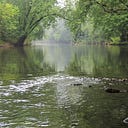Mussels exhibit opens at nature center
Friends group, partners add feature to Austin interpretive facility
Oct. 5, 2022 — Long before it was known as “Spamtown,” Austin had the nickname “Pearl City.”
From about 1890 through the early 1900s, the city took on this name due to the number of pearls being harvested from native mussels or clams in the Cedar River. At the end of the 1900 season, the Austin Daily Herald reported a man and his son opened more than 1,200 clams — which killed the animals — only to find a little pearl worth 50 cents at the time.
“Austin has a number of tireless hunters after pearls,” the Herald wrote Nov. 28, 1900. “The supply of clams is about exhausted although many fine pearls will be taken from the river from time to time.”
Aside from overharvesting mussels, pollution in the Cedar River also took its toll on their numbers for decades but now they are making a comeback.
Today, the Friends of the Hormel Nature Center unveiled a new exhibit all about mussels in its interpretive center, covering their history in Austin (“Pearl City”), interesting names, importance for a river’swater quality and the ongoing efforts in recent years to revive mussels in the Cedar River thanks to the Minnesota Department of Natural Resources.
“Mussels are fascinating animals that play an important role in the health of a river,” said Luke Reese, director of the Jay C. Hormel Nature Center, part of the city’s Parks & Recreation Department. “We are excited to share this new, interactive and eye-catching exhibit with people of all ages to get to know mussels and help us protect them in the years ahead.”
This nearly $140,000 exhibit — free to the public — is the newest feature to the nature center’s $7 million interpretive center opened in 2017 to replace its original facility.
The Friends of the Hormel Nature Center, a nonprofit organization, funded about $120,000 of the project. The other $20,000 coming from Mower and Freeborn counties’ state funds for aquatic invasive species prevention and awareness, which is part of the exhibit’s messaging.
Partnering on the project with the Friends were the Jay C. Hormel Nature Center staff, Cedar River Watershed District and the DNR’s mussel biologists. Exhibit designer Sarah Zwier led the planning and production process.
Two major components of the exhibit are a painted mural showing below and above water in a stream similar to the nature center’s Dobbins Creek along with a wall-size aerial image showing the City of Austin and much of the surrounding watershed, including Dobbins.
It also features an animated video — “Return of the Mussels: From Pearls and Pollution to a Scientific Solution” — about the DNR’s efforts to restore mussels in the Cedar. This is next to a touch-and-feel model of a clam 12 times the size of a real mussel.
Since 2016, the DNR has worked on growing native mussels in Austin’s East Side Lake — which is a part of Dobbins Creek, a Cedar River tributary — that later are taken out and placed in the Cedar River along a nearly 15-mile stretch between Austin’s downtown dam and the Minnesota-Iowa border.
Thanks to the Mower County Historical Society, the exhibit also features pearls taken from Cedar River clams long ago and a large clam shell with numerous holes drilled through it for making buttons for clothing. The LeBarron family also donated Cedar River pearls to the Friends for the display.
“This exhibit hits home for the Friends’ mission of enhancing and encouraging environmental education, scientific opportunities and the enjoyment of nature,” said Tim Ruzek, president of the Friends group and CRWD’s outreach coordinator. “We hope this project will continue the strong momentum to restore native mussels here and in other rivers.”
Madeline Pletta, a state mussels propagation biologist, led the DNR’s role in planning the mussels exhibit. She has led the efforts locally that has placed 6,818 native mussels in the Cedar River since July 2019 at three sites in Mower County. The vast majority of those have been black sandshell mussels.
“We love how this exhibit turned out and how well it emphasizes the many benefits of restoring mussels to a river,” said Pletta, who is with the DNR’s Center for Aquatic Mollusk Programs.
The DNR mussels reintroduction efforts for the Cedar River and elsewhere is funded by the state’s Legislative Citizen Commission on Minnesota Resources (LCCMR).
Mussels serve as filters in a river to support water quality, provide microhabitats for smaller aquatic creatures like invertebrates and stabilize the river bottom. Freshwater mussels provide vital ecological services and can live for several decades and, in some cases, a century or more.
DNR surveys show, however, that the Cedar and other rivers in Minnesota’s southern one-third no longer support their historical assemblages of mussel species.
In Minnesota, it is illegal to collect live mussels and possess the shells of dead mussels that are state-listed species.
